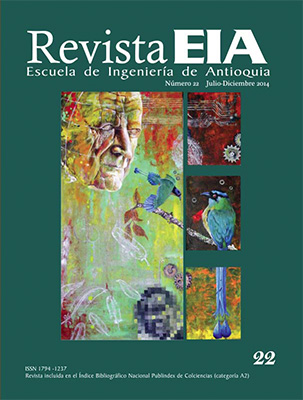LA INFRAESTRUCTURA DE PUENTES EN LAS VÍAS SECUNDARIAS DEL DEPARTAMENTO DE ANTIOQUIA
LA INFRAESTRUCTURA DE PUENTES EN LAS VÍAS SECUNDARIAS DEL DEPARTAMENTO DE ANTIOQUIA


Esta obra está bajo una licencia internacional Creative Commons Atribución-NoComercial-SinDerivadas 4.0.
Declaración del copyright
Los autores ceden en exclusiva a la Universidad EIA, con facultad de cesión a terceros, todos los derechos de explotación que deriven de los trabajos que sean aceptados para su publicación en la Revista EIA, así como en cualquier producto derivados de la misma y, en particular, los de reproducción, distribución, comunicación pública (incluida la puesta a disposición interactiva) y transformación (incluidas la adaptación, la modificación y, en su caso, la traducción), para todas las modalidades de explotación (a título enunciativo y no limitativo: en formato papel, electrónico, on-line, soporte informático o audiovisual, así como en cualquier otro formato, incluso con finalidad promocional o publicitaria y/o para la realización de productos derivados), para un ámbito territorial mundial y para toda la duración legal de los derechos prevista en el vigente texto difundido de la Ley de Propiedad Intelectual. Esta cesión la realizarán los autores sin derecho a ningún tipo de remuneración o indemnización.
La autorización conferida a la Revista EIA estará vigente a partir de la fecha en que se incluye en el volumen y número respectivo en el Sistema Open Journal Systems de la Revista EIA, así como en las diferentes bases e índices de datos en que se encuentra indexada la publicación.
Todos los contenidos de la Revista EIA, están publicados bajo la Licencia Creative Commons Atribución-NoComercial-NoDerivativa 4.0 Internacional
Mostrar biografía de los autores
RESUMEN
Las vías terrestres son la principal herramienta para el desarrollo comercial y económico de una región. La falla de un puente en un proyecto vial genera la interrupción total del tráfico de bienes en su superficie, produciendo cuantiosas e incalculables pérdidas mientras se restituye el normal flujo vehicular. Antioquia cuenta con una de las redes viales secundarias más extensas del territorio colombiano, y en ella hay un número importante de puentes que conforman su patrimonio vial. Gran porcentaje de estos puentes no han recibido un mantenimiento adecuado desde su construcción posibilitando la aparición de fallas en su estructura e incluso su eventual colapso. El inventario realizado a la totalidad de puentes de las vías secundarias del departamento de Antioquia identificó los principales parámetros físicos del puente, su tipología constructiva, el tipo de estructura y el nivel de daños presentado. Como resultado se observa que la tipología estructural más empleada es la de puentes de concreto reforzado, con una longitud de mayor repetición entre 5m y 10m, de los cuales el 11 % requiere una intervención inmediata por el nivel de daños presentados y el 48 % de ellos se encuentran funcionando adecuadamente.
ABSTRACT
The roads are the main tool for business and economic development of a region. Bridges failures generate the interruption in the normal traffic, producing many and incalculable losses while the normal traffic is restored. Antioquia is one of the longest road networks in Colombia with several numbers of bridges that conform its road infrastructure assets. Many of these bridges have not been properly maintained since its construction, which can cause structural failures and even its possible collapse. The inventory bridges made in every departmental road in Antioquia identified the main physical parameters of the bridge, the building type, the type of structure and the current level of damage. The inventory showed that reinforced concrete is the most common structural type used in bridges, with most common length between 5m and 10m, inventory also showed that 11 % of the bridges require immediately intervention due to several damages in their structure and 48 % of them are working properly.
Visitas del artículo 591 | Visitas PDF 252
